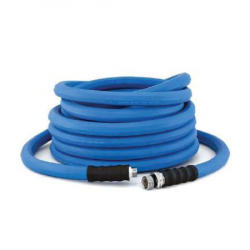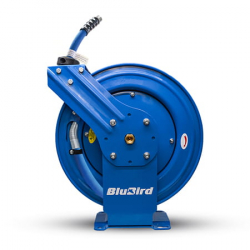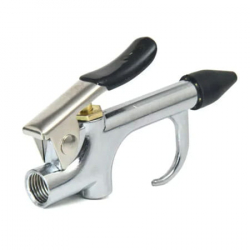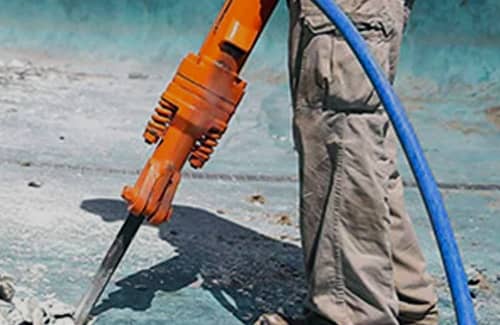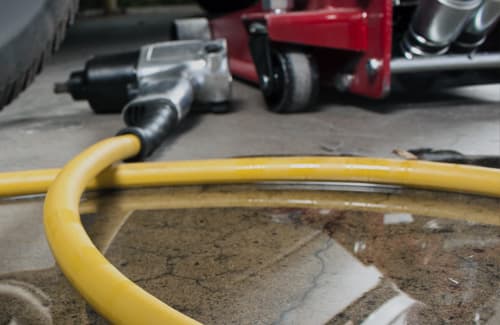BluShield Pressure Washer Hose & Hose Reels
What is cavitation in the engine?
How does the BluShield Pressure Washer Inlet hose help prevent cavitation in the engine?
What is the purpose of an “inlet” hose?
Why is a high burst pressure PSI important?
Do you make a DIY hose for pressure washing?
What does the 1-year warranty include?
Why is the BluShield 100% rubber hose superior to the competition?
What coupling options does the BluShield Pressure Washer hose have?
What is a 4:1 safety factor?
What is the hottest water temperature that the BluShield Pressure Washer hose will tolerate?
What is the coldest temperature that the BluShield Pressure Washer hose will maintain its flexibility?
What does ozone resistant mean?
How are the hoses abrasion resistant?
What does kink resistant mean?
What sizes do the BluShield Pressure Washer Hoses come in?
Answer:
Cavitation of the water pump engine is the formation & accumulation of bubbles in the pumping chamber on your high pressure pump. When these bubbles are put under pressure they collapse or burst which can create implosions inside the water hose and equipment, affecting the surrounding parts. One of the most common problems in pressure washers is premature pump failure, most often caused by cavitation.
Answer:
The water in, is as important as the water out. The bigger the diameter of your inlet house, the better the performance of your equipment. The most common cause of cavitation is the inlet fittings on your pressure cleaner not being tight enough, or not being sealed properly causing air to be sucked into the pump. The best way to combat cavitation is to have healthy water flow and maintain the seals in your pump. BluBird designs our products to maximize water flow.
Answer:
Your pressure washer needs water in and the larger the diameter of your inlet hose the greater water flow is into your pressure washer. This means less interruption of the flow of water and allows your pressure washer to operate more efficiently.
Answer:
There is direct correlation with the burst pressure and the working pressure. The standard in the industry is a 4:1 ratio referred to as a safety factor. The standard is to divide the burst pressure of the hose by 4, and that will give you the working pressure. A hose with a burst pressure rating of 3100 psi will Some manufacturers cheat and say their hoses have a working rating of 300 psi but at a 4:1 safety factor, their hose has a burst rating of 1200 psi. All BluBird hoses have at least a 4:1 safety factor.
Answer:
BluBird makes the 3100 psi, polyester braided BluShield Pressure Washer hose. The difference is that this hose does not use the Aramid fiber braid and while rated for hot water, is traditionally a cold water hose.
Answer:
The warranty covers manufacturing defects. Should a fitting blow off, a leak occurs at the crimped ends or a hose bursts for no apparent reason, the hose needs to be returned and inspected. If a defect is present, it will be self-evident and fully covered by warranty. Wear and tear and misuse are not covered by the warranty. A one year warranty is the best warranty in the pressure washing industry.
Answer:
If you use hot water, you have to use a rubber hose. Rubber is the only material that handles hot water. There are other rubber pressure washer hoses on the market. They are basically a hydraulic hose that’s heavy and stiff because of the way they are manufactured. The manufacturing process of the BluShield pressure washer hose results in a hose that is 100% rubber, and the lightest most flexible hose ever made. It is much more flexible than the ones that are available in the market or come with the pressure washers as those are blend of PVC or TPR )ThermoPlastic Rubber)
Answer:
The BluShield Pressure Washer hoses come with a stainless steel male fixed and a male swivel coupling. One at each end.
Answer:
The industry standards have always said that a hose should have a factor of 4 to 1. This means that if a hose says it’s a 4100 psi working pressure hose, the pressure that will cause it to burst should be 4x the working pressure, or 16,400 psi.
Answer:
The BluShield Pressure Washer Hose will tolerate up to 250°F.
Answer:
The BluShield Pressure Washer Hose maintains cold water flexibility down to -20°F.
Answer:
Ozone Weather Resistance is the ability of rubber to withstand the effects of exposure to Ozone. Ozone and UV light can affect a hose, causing the hose to deteriorate over time. The BluShield Pressure Washer hose is an Nitrile rubber, which is resistant to the effects of Ozone and UV exposure.
Answer:
The BluShield Pressure Washer hose is naturally abrasion resistant because it’s made from Nitrile rubber with good abrasion resistance.
Answer:
Rubber has no memory, so it lays flat and doesn’t kink. Kinking is a bend in the hose that restricts the flow of water.
Answer:
The BluShield Pressure Washer comes in 1/4" 3/8" in the inside Diameter. The lengths are up to 200'. The standard lengths are 25', 35', 50' 75', 100' and 200'.
BluBird Rubber Air Hoses
How and why is the hose 40% lighter?
What makes BluBird Heavy-Duty Rubber Air Hoses different from other materials?
How does the chemical makeup of BluBird Rubber Air Hoses contribute to their performance?
Why is 100% rubber superior?
What does the 10-year warranty include?
Why are brass fittings superior to aluminum?
What does polyester woven braided reinforcement mean for the product, and how does it work?
How does 300 PSI compare to the competition?
What is a 4:1 safety factor?
What do we consider extreme weather conditions?
What does ozone resistance mean?
How are the hoses abrasion-resistant?
What does kink resistant mean?
Why is the 4-finger grip bend restrictor important?
What sizes do the Next-Gen Rubber Air Hoses come in?
Do we manufacture other-size fittings?
Answer:
The BluBird Hose is the lightest, strongest, most flexible 100% rubber hose. Before the introduction of BluBird, rubber hoses were heavy and stiff, which allowed the introduction of Hybrid hoses into the market. Hybrids are a combination of rubber, PVC, and other low-cost ingredients with higher specific gravity, making the hoses heavier and prone to cracking. Blubird took out the cheap ingredients and added higher-quality materials to make the hose lighter. In the past ten years since we introduced Blubird Hoses to the market, the return % is well below 0.50% despite having a ten-year warranty.
Answer:
BluBird Heavy-Duty Rubber Air Hoses are a solution to common issues seen in materials like Nylon, PVC, PU, and Hybrid hoses. They are durable, extremely flexible, and do not kink, making them suitable for various applications.
Answer:
The inner layer is made with NR (natural rubber), providing exceptional elasticity and kink recovery. It is enhanced with BluBird rubber technology, making it twice as strong as traditional rubber. The hose is reinforced with polyester braided yarn, offering extra strength and protection against abrasion, ozone, heat, UV, and wear and tear.
Answer:
The hose industry knows that rubber is the best material to use. Even hybrid manufacturers use a certain percentage of rubber in their hoses because of rubber's advantages over PVC. PVC is light and flexible but doesn't perform well in cold temperatures. Rubber outperforms PVC in cold weather and also has flexibility, maintaining strength. PVC hoses lose their pressure rating safety factor when it is warm or hot. The pressure rating drops drastically when the outside temperature is over 80-85F.
Answer:
The warranty covers manufacturing defects. Should a fitting blow off, a leak occurs at the crimped ends or a hose burst for no apparent reason, the hose needs to be returned and inspected. If a defect is present, it will be self-evident and fully covered by warranty. Wear and tear and misuse are not covered by the warranty. Ten years is the best warranty in the market.
Answer:
Aluminum fittings are lighter than brass but are very soft, and easily crushed if a hose is run over. Brass is slightly heavier but much more durable, overall a better fitting.
Answer:
Some manufacturers spiral braid their hoses, and that process doesn’t have the same effect on the strength of the hose. Braiding helps the core pressure rating as it is placed over the core of the hose before the cover is added. Woven braiding is the best. It’s done using machines that weave the braiding over the middle (core) and add strength to the hose.
Answer:
300psi is the standard working pressure for most hoses. The standard is to divide the burst pressure of the hose by 4, and that will give you the working pressure. Some manufacturers cheat and say their hoses are 300psi when they aren’t, as their burst pressure is less than 4:1 (1200 psi).
Answer:
The industry standards have always said that a hose should have a factor of 4 to 1. This means that if a hose says it’s a 300-psi hose, the pressure that will cause it to burst should be 4x the working pressure.
Answer:
The pressure ratings for a hose are based on testing at an ambient temperature of 70°F. As the hose is exposed to warmer temperatures above 70°F and lower temperatures, it will affect the performance of the hose. Loss of pressure rating and hose integrity. We test all of the hoses to the highest and lowest temperatures where the hose maintains its integrity and pressure ratings. Ours is the best in the industry for either warm or cold temperatures. -50°F to +190°F for the BluBird hoses.
Answer:
Ozone Weather Resistance is the ability of rubber to withstand the effects of exposure to Ozone. Ozone and UV light can affect a hose, causing the hose to deteriorate over time. The Blubird hose is an EPDM rubber, which is resistant to the effects of Ozone and UV exposure.
Answer:
The BluBird hose is naturally abrasion resistant because it’s made from an EPDM rubber with good abrasion resistance.
Answer:
Rubber has no memory, so it lays flat and doesn’t kink. Kinking is a bend in the hose that restricts the airflow.
Answer:
The bend restrictor is put on each hose end to protect the end fittings. The ends are the most vulnerable parts of the hose. Without the bend restrictor, the fittings can be damaged when bent. We developed the four-finger grip to conform to the user’s fingers, making the hose easier to hold and handle. This bend restrictor is proprietary to us.
Answer:
Our primary offering for the BluBird Air Hose is ¼”, 3/8”, ½” & 1”. These are all I.D. (internal dimension) sizes.
Answer:
We don’t manufacture fittings. We source them from fitting manufacturers to meet the specs for our hoses.
OilShield Air Hoses
How and why is the hose 30% lighter?
Why is 100% rubber superior?
What does the 3-year warranty include?
Why is Class A designation significant?
Why are brass fittings superior to aluminum?
What does polyester woven braided reinforcement mean for the product, and how does it work?
How does 300 PSI compare to the competition?
What is a 4:1 safety factor?
What do we consider extreme weather conditions?
What does abrasion resistant mean?
What does kink resistant mean?
Why is the 4-finger grip bend restrictor important?
What sizes do the Next-Gen Rubber Air Hoses come in?
Do we manufacture other-size air hose fittings?
Answer:
The OilShield Air Hose is the lightest, strongest, most flexible 100% rubber hose. Before the introduction of OilShield, rubber hoses were heavy and stiff, which allowed the introduction of Hybrid hoses into the market. Hybrids are a combination of rubber and PVC. Unlike PVC and Hybrid hoses, BluBird's OilShield hose is resistant to spilled oil and, more importantly, to welding spatter and sparks. The OilShield hose withstands these, whereas the PVC or Hybrid would get punctured and eventually burst. The Lighter demo is a perfect example.
Answer:
The hose industry knows that rubber is the best material to use. Even the hybrid manufacturers use a certain % of rubber in their hoses because of the advantages rubber has over PVC. PVC is light and flexible but doesn’t perform well in cold temperatures. Rubber outperforms PVC in cold weather, maintaining flexibility and strength. Nitrile rubber is also resistant to spilled oil, and welding spatter and sparks. PVC and Hybrid hoses are not.
Answer:
The warranty covers manufacturing defects. Should a fitting blow off, a leak occurs at the crimped ends or a hose burst for no apparent reason, the hose needs to be returned and inspected. If a defect is present, it will be self-evident and fully covered by warranty. Wear and tear and misuse are not covered by the warranty. Three years is the best warranty in the market for a Class A, oil resistant hose.
Answer:
There are three Categories of high-pressure air hoses: Oil Resistant Class A (High Oil Resistance) or Class B (Medium Oil Resistance) and Class C (Non-Oil Resistant and Limited Oil Resistant). The Lower Pressure Hoses are Generally Used for Applications such as air guns, industrial air lines in industrial facilities, service stations, and many others. The more resistant a shop hose is to oil and solvents, the longer it will remain in service.
Answer:
Aluminum fittings are lighter than brass but are very soft, and easily crushed if a hose is run over. Brass is slightly heavier but much more durable, overall a better fitting.
Answer:
Some manufacturers spiral braid their hoses, and that process doesn’t have the same effect on the strength of the hose. Braiding helps the core pressure rating as it is placed over the core of the hose before the cover is added. Woven braiding is the best. It’s done using machines that weave the braiding over the middle (core) and add strength to the hose.
Answer:
300psi is the standard working pressure for most hoses. The standard is to divide the burst pressure of the hose by 4, and that will give you the working pressure. Some manufacturers cheat and say their hoses are 300psi when they aren’t, as their burst pressure is less than 4:1 (1200 psi).
Answer:
The industry standards have always said that a hose should have a factor of 4 to 1. This means that if a hose says it’s a 300-psi hose, the pressure that will cause it to burst should be 4x the working pressure.
Answer:
The pressure ratings for a hose are based on testing at an ambient temperature of 70°F. As the hose is exposed to warmer temperatures above 70°F and lower temperatures, it will affect the performance of the hose. Loss of pressure rating and hose integrity. We test all of the hoses to the highest and lowest temperatures where the hose maintains its integrity and pressure ratings. Ours is the best in the industry for either warm or cold temperatures. -30°F to +190°F for the OilShield hoses.
Answer:
Abrasion resistant hoses are suitable to convey concrete, plaster, grout, sand and gypsum. The OilShield Air Hose is designed to handle abrasive mediums and consequently will maintain a longer in-service time.
Answer:
Rubber has no memory, so it lays flat and doesn’t kink. Kinking is a bend in the hose that restricts the airflow. Kink-Memory, as it is referred to in the industry, affects most hoses. The cheaper the hose, the lesser the materials, and the more memory a hose will contain. Hoses produced with plasticized PVC are the worst, while rubber ones are the best. All hoses are affected by a phenomenon called "compression set." All hoses tend to have some memory when first uncoiled. The coil's size is small to save on shipping costs. To have the best results and less memory, we suggest that the coil be opened and laid flat and then when it is to be stored, make a bigger coil.
Answer:
The bend restrictor is put on each hose end to protect the end fittings. The ends are the most vulnerable parts of the hose. Without the bend restrictor, the fittings can be damaged when bent. We developed the four-finger grip to conform to the user’s fingers, making the hose easier to hold and handle. This bend restrictor is proprietary to us.
Answer:
Our primary offering for the OilShield Air Hose is ⅜”, ½”. These are all I.D. (internal dimension) sizes.
Answer:
We don’t manufacture fittings. We source them from fitting manufacturers to meet the specs for our hoses.
Air Hose General Questions
What is an air hose?
What are the different types of air hoses?
What are the benefits of using an air hose?
How do I choose the suitable air hose for my needs?
How should I maintain my air hose?
How long does an air hose last?
What is the maximum pressure rating for air hoses?
Answer:
An air hose is a flexible tube that transports compressed air from an air compressor to various tools and equipment.
Answer:
There are several air hoses, including rubber, PVC, and polyurethane. Rubber hoses are the most durable and can withstand high temperatures and pressure. PVC hoses are lightweight and economical, while polyurethane hoses are flexible and resistant to oil and chemicals.
Answer:
Air hoses provide a convenient and efficient way to supply compressed air to power tools and equipment. They can also be used in various industrial settings, such as factories and workshops, to power pneumatic tools and machinery.
Answer:
When choosing an air hose, consider the type of application it will be used for, the pressure and temperature requirements, and the flexibility and durability required. It is also essential to consider the compatibility of the hose with the fittings and connectors used in your equipment.
Answer:
To maintain your air hose, it's essential to keep it free of kinks, twists, and knots. It should also be stored in a cool, dry place when not in use. To prolong the life of your hose's life, an air hose reel is recommended to keep it coiled and protected when not in use.
Answer:
The lifespan of an air hose can vary depending on the type of material it is made from and the level of use it receives. A rubber air hose can last several years with proper care and maintenance.
Answer:
The maximum pressure rating for air hoses can vary depending on the type of hose, but most hoses are rated for a maximum of 300 PSI.
BluSeal Water Hoses
How and why is the hose 40% lighter?
Why is 100% rubber superior?
What does the 10-year warranty include?
Why are chrome plated brass fittings superior to aluminum?
What does the “No memory” mean for the product, and how does it keep the hose laying flat?
How does 500 PSI Burst Pressure compare to the competition?
What do we consider extreme weather conditions?
What does ozone resistance mean?
How are the hoses abrasion-resistant?
Why is the 4-finger grip bend restrictor important?
What I.D sizes & lengths do the BluSeal Water Hoses come in?
Answer:
If you use hot water you have to use a rubber hose. Traditionally made rubber water hoses are heavy and stiff. The BluSeal and AG-Lite Hoses were formulated to be the lightest, strongest, most flexible 100% rubber water hoses ever made.
Answer:
The hose industry knows that rubber is the best material to use. Even hybrid manufacturers use a certain percentage of rubber in their hoses because of rubber's advantages over PVC. PVC is light and flexible but doesn't perform well in cold temperatures. Rubber outperforms PVC in cold weather and also has flexibility and also maintaining strength. PVC hoses lose their pressure rating safety factor when it is warm or hot. The pressure rating drops drastically when the outside temperature is over 70°F The BluSeal/AgLite hoses have a cold weather flexibility rating of -50°F and also maintains its pressure ratings up to +190°F.
Answer:
The warranty covers manufacturing defects. Should a fitting blow off, a leak occurs at the crimped ends or a hose bursts for no apparent reason, the hose needs to be returned and inspected. If a defect is present, it will be self-evident and fully covered by warranty. Wear and tear and misuse are not covered by the warranty. Ten years is the best warranty in the market.
Answer:
Aluminum fittings are lighter than brass but are very soft, and easily crushed if a hose is run over. Brass and Chrome plated brass is slightly heavier but much more durable, overall a better fitting. The fittings included on BluBird’s BluSeal and AG-Lite hoses are crush proof.
Answer:
Kink-Memory, as it is referred to in the industry, affects most hoses. The cheaper the hose, the lesser the materials, and the more memory a hose will have. Hoses produced with plasticized PVC are the worst, while rubber ones are the best. All hoses are affected by a phenomenon called "compression set." All hoses tend to have some memory when first uncoiled. The coil's size is small to save on shipping costs. To have the best results and less memory, we suggest that the coil be opened and laid flat and then when it is to be stored, make a bigger coil. The best option is to have a hose reel for up to 100' of hose, and for over that length, we offer carts with flat free tires.
Answer:
Garden hoses are manufactured to withstand a certain amount of burst pressure. The pressure at which they split is referred to as a burst pressure rating. A low-quality hose will burst at about 200 psi, and a high-quality hose can hold together up to 500 psi.
Answer:
The pressure ratings for a hose are based on testing at an ambient temperature of 70°F. As the hose is exposed to warmer temperatures above 70°F and lower temperatures, it will affect the performance of the hose. Loss of pressure rating and hose integrity. We test all of the hoses to the highest and lowest temperatures where the hose maintains its integrity and pressure ratings. Ours is the best in the industry for either warm or cold temperatures. -50°F to +190°F for the BluSeal hoses.
Answer:
Ozone Weather Resistance is the ability of rubber to withstand the effects of exposure to Ozone. Ozone and UV light can affect a hose, causing the hose to deteriorate over time. The BluSeal hose is a proprietary blend of EPDM rubber and chemicals, resistant to the effects of Ozone and UV exposure.
Answer:
The BluSeal hose is naturally abrasion resistant because it’s made from an EPDM rubber with good abrasion resistance.
Answer:
The bend restrictor is put on each hose end to protect the end fittings. The ends are the most vulnerable parts of the hose. Without the bend restrictor, the fittings can be damaged when bent. We developed the four-finger grip to conform to the user’s fingers, making the hose easier to hold and handle. This bend restrictor is proprietary to us.
Answer:
Our primary offering for the BluSeal Water Hose is 6’, 15’, 25’, 50’, 75’, 100’. But BluBird Industries also provides longer lengths for use in bigger areas and loaded onto carts.
The hoses are available in ½”, ⅝”, ¾” & 1” I.D’s. All of them come with ¾” GHT end fittings.
The hoses are available in ½”, ⅝”, ¾” & 1” I.D’s. All of them come with ¾” GHT end fittings.
Fleet Edition Tire Inflator Kit
What is the Fleet Edition Kit used for?
What’s in the Fleet Edition Tire Inflator Kit?
Is there anything special about the air hose?
Is there any warranty on the fittings?
How do I use the kit?
What is the warranty on the BluBird air hose in the kit?
What is considered a manufacturing defect?
Answer:
The Fleet Edition Tire Inflator Kit enables you to connect to the air supply from a Semi or other vehicle equipped with compressed air to an air hose for refilling low tires and also providing air for air tools.
Answer:
The Fleet Edition Kit has all the components needed to fill tires and run air tools. Inside the kit there is 50’ of the BluBird ⅜” air hose, a dual aluminum universal glad hand made by Phillips Industries, a dual chuck tire inflator and teflon tape. The glad hand also is fitted with a ¼” - ½” adapter that allows the use of air tools such as an impact wrench. All of the components are inside a zippered, reusable carry and storage bag.
Answer:
Absolutely. The BluBird air hose in the kit is the lightest, strongest, most flexible, 100% rubber air hose ever made. It has the best cold weather flexibility rating of -50°F and a warm/hot weather rating of +190°F. The hose is covered by an industry leading 10 year warranty against manufacturing defects.
Answer:
Yes. 2 year warranty on the fittings.
Answer:
It’s very simple to use. All you do is connect the glad hand to one end of the hose. Then connect the tire inflator to the other end of the hose. When that’s done, disconnect the air supply going to the trailer and connect the glad hand on the end of the hose to that air supply glad hand and you're done. You now have air going through the hose.
Answer:
The BluBird Air hose has a 10 year warranty on manufacturing defects.
Answer:
A manufacturing defect would be if a fitting blows off or leaks or if the hose bursts or swells and there is no visible damage to the hose.
OilShield Fuel Transfer Hose
What is a fuel transfer hose?
What fluids can the hose be used to transfer?
What is the hose made out of?
Kinking is an issue with Fuel transfer hoses isn’t it?
What’s an internal strain relief spring?
Is the hose Ozone and abrasion resistant?
Can the hose be used with electric pumps?
What’s the warranty on the hose?
Is the hose approved where UL approval is required.
What are the common ID’s?
Are the fuel transfer hoses available on retractable reels?
What fittings are on the fuel transfer hose?
Does the hose have bend restrictors on each end?
Answer:
A fuel transfer hose is the hose that’s used to transfer fuel and other liquids from the tank to the vehicle.
Answer:
The OilShield Fuel Transfer hose can be used with Diesel, Gasoline, Kerosene, BioDiesel B10 & B20.
Answer:
The hose is made out of 100% Nitrile rubber. It has a Nitrile core and cover giving it a Class A Oil-Resistant rating.
Answer:
Yes, kinking is one of the biggest complaints with Fuel Transfer hoses. The OilShield fuel transfer hose is 2X’s more kink resistant than other fuel hoses on the market. This is due to how the OilShield hose is manufactured.
Answer:
The internal strain relief spring helps prevent kinking at the coupling. The OilShield Fuel transfer hose has 8” internal strain relief springs at both ends of the hose to help prevent kinking.
Answer:
The OilShield hose is Ozone and abrasion resistant due to its Nitrile rubber cover.
Answer:
Yes. The hose has a static wire inside the core which makes it usable for electric pumps.
Answer:
1 year warranty against manufacturing defects.
Answer:
No, the hose is not UL approved but can be used anywhere where the UL approval is not required.
Answer:
The two most common are ¾” and 1” ID’s.
Answer:
Yes, they are available. ¾” x 25’ and 50’ Retractable hose reels.
Answer:
The fittings on the ¾” hose are ¾” NPT which fit most fuel nozzles The 1” have 1” NPT fittings.
Answer:
Yes. Each end of the hose has our proprietary four find grip bend restrictor which protects the ends of the fittings and also allows greater use and manageability of the hose.

